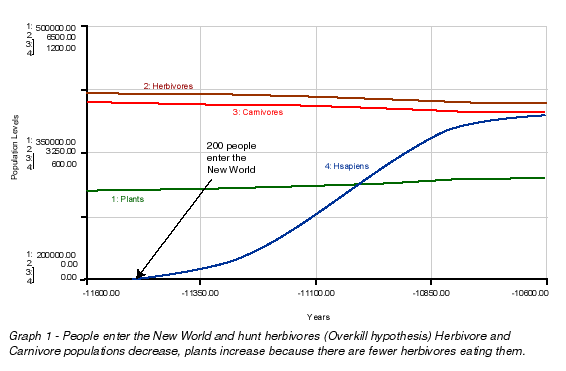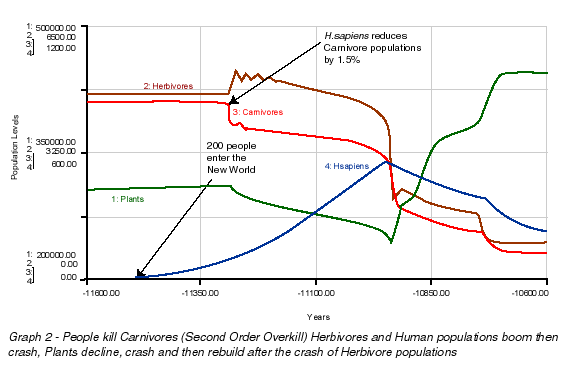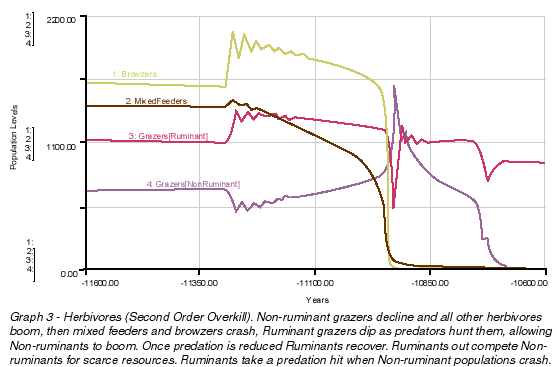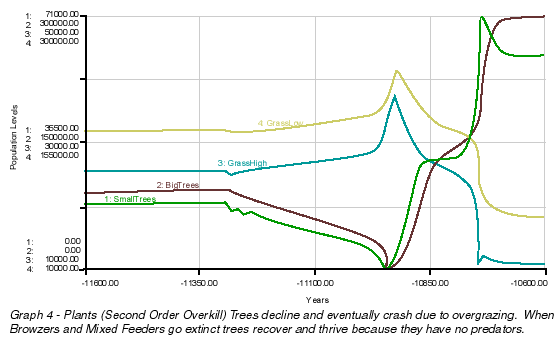

There are mammoths being killed by massive lions and sabertooth cats. Bison are almost as big as elephants. Beavers are as big as bears, the short faced bear stands more than 5 foot at the shoulder, almost twice the size of a grizzly bear. These big animals merit their name - mega-fauna.
Eight thousand years later the ice caps are wasting away. Paleo-indians are using beautiful fluted points to hunt the bison the mastodons and other mega-fauna in park lands of North and South America. They work little - about 8 hours per week - and live well. Game and vegetation is available for the taking. Theirs is a world of plenty - an Eden.
Just a thousand years later, the huge ice caps, horses, sloths, other giant animals, the carnivores that ate them, and the paleo-indians, all are gone. Climate is like it is today. The parklands are gone. There are belts of closed canopy forest on the coasts and a vast grassland in the center of the North American continent.
The few people we find are living in small isolated bands. Their stone technology is far less developed than that of the paleo-indians. Who are these people? What happened to the Paleo-Indian culture?
Why did the pattern of vegetation change? Why are bison and beavers so small? Where are the mastodon, the mammoth, the horse and the big cats who hunted them?
These are the mysteries of the extinctions at the end of the last Ice Age.
Two theories have been put forward to explain them - climate change and overkill by people. (See Pleistocene Extinctions: The Search for a Cause edited by P.S. Martin and H. E. Wright, Jr., published by Yale Univ. Press in 1967 and Quaternary Extinctions: A Prehistoric Revolution edited by P.S. Martin and R. G. Klein published by Arizona Univ. Press in 1984.)
Vastly simplified, the climate change hypothesis suggests that as the ice age waned climate changed so drastically that animals were not able to adapt. The overkill hypothesis suggests that humans swept into the New World killing everything in their path.
The problems with these theories are:
New World carnivores were probably easier to kill than those of Africa and Asia because they had no instinctive fear of humans.
Also without instinctive fear New World carnivores may have killed people.
People are dangerous game - they remember and establish policies like, "The only good carnivore is a dead carnivore."
Reducing carnivore populations by a relatively small amount changed the ecological balance. Herbivore populations boomed.
Herbivores ate everything in sight. When the vegetation was gone they died of starvation. The ones who depended on the slowest growing resources (trees) died first (browzers and mixed feeders like mastodons). They were followed by grass eaters who were less efficient (non-ruminants like horses, mammoths and sloths).
Specialist carnivores who depended upon the mega-fauna went extinct.
The survivors had less game to hunt. They had to deal with other carnivores (human and non-human) who could not find enough game. Those who made it were those who could deal with scarcity.
Generalist carnivores and scavengers like wolves and smaller cats.
People who were willing to change their life style and earn their living through primitive planting, fishing, foraging, and scavenging. People living in small isolated groups wary of those who might take away their subsistance.
The ecosystem consists of two kinds of plants - trees and grass, four kinds of herbivores - browzers, mixed feeders, ruminant and non-ruminant grazers. I simulated Overkill (Graph 1) and Second Order Overkill (Graph 2 ). The graphs show that hunting herbivores has far less impact than does killing carnivores.


If we look behind the scenes in the Second Order Overkill simulation, browzers, mixed feeders and non-ruminant grazers go extinct (Graph 3). The immediate cause of their extinction is overgrazing (Graph 4). The browzers and mixed feeders eat all the trees and then starve.


If this model is correct for the New World, we know why the pattern of vegetation changed, why animals not hunted by people went extinct, and why horses went extinct even though they can live in our climate.
Comparing the Overkill Hypothesis and the Second Order Overkill Hypothesis suggests new insights into the peopling of the New World:
Then, with the crash, people starved. Smaller animals and the denuded vegetation could only support small bands widely spaced out over the landscape. They were isolated. It was a land of scarcity. In that harsh world there was less leisure to create beautiful points and many of the people with the skills to do so had starved - paleo dark ages. As in other dark ages, skills were lost and the quality of life reduced.
This would suggest that it is easier than we think to upset the ecological balance.
If the theory is more generally true and applicable to other places, including the fertile crescent, it may be the motivating push behind the shift from hunting and gathering to planting and farming. It implies that religious stories of a golden time past in the Genesis and elsewhere, have a basis in fact. They explain the shift from the boom time - Eden - when people had more than enough food to eat and it was freely available for the taking to the time of starvation and scarcity.
Return to the Extinctions Menu Page